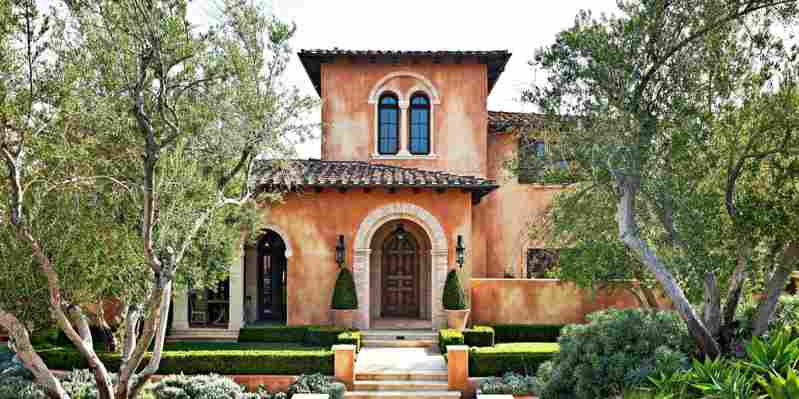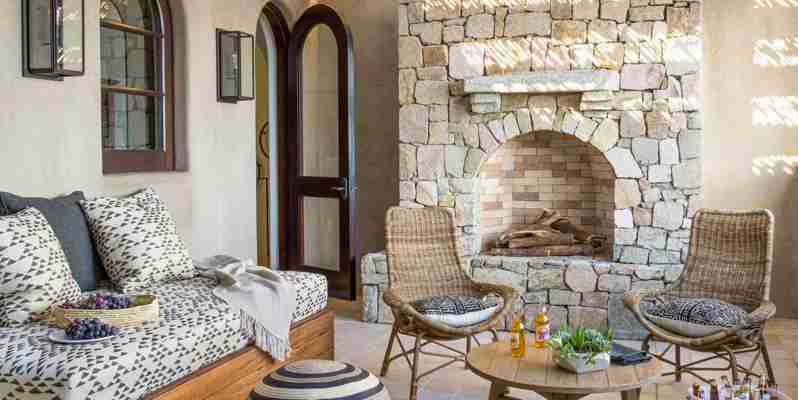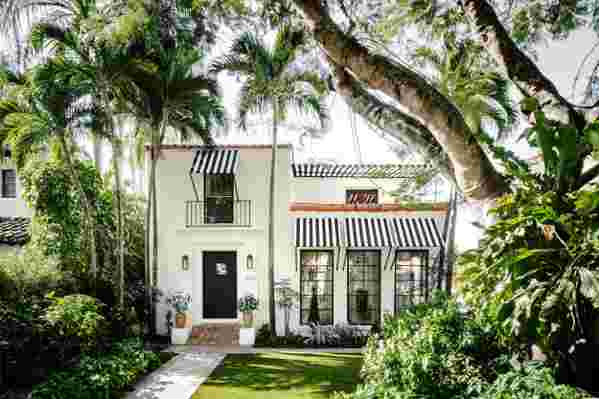June 06,2023
Everything You Need to Know About Mediterranean-Style Homes
by Jennifer Cameron inMediterranean Style
16 Mediterranean-Style Homes with Global-Inspired Beauty
Mediterranean style varies depending on the specific architectural influences, but many of these homes showcase similar exterior elements. Typical characteristics include:

Arched windows and doors.
Wrought-iron details.
Clay roof tiles.
Stucco walls.
Spacious outdoor living areas.
Several of these distinctive exterior Mediterranean features, including the stucco and roof materials, are intended to help keep these homes cool in hot, sunny climates.
Characteristics of Mediterranean Houses
Mediterranean-style homes, which resemble the aesthetic of Mediterranean villas, originated in the 1920s. During this period—the Roaring Twenties—people were consumed with wealth and leisure, resulting in the rise of seaside resorts in the United States.

A blend of Spanish and Italian architecture, Mediterranean homes are dominant in warm-weather locations like California and Florida, which also have Spanish influences. Popular architects at the time were Addison Mizner, who advanced this home style in Florida, along with Bertram Goodhue, Sumner Spaulding, and Paul Williams in California.
Alison Davin of Jute Home and DKOR Interiors' Ivonne Ronderos provided us with background on the common characteristics of Mediterranean houses and their top decorating tips to consider.
Main Characteristics
A Mediterranean house is a dream for someone who appreciates simple, yet elegant, spaces. "It's timeless and quintessential California," says Jute Home's Alison Davin, who is based in California. "If you want a house that is not trending and won't require updating—one with really warm woods, bright walls, and indoor-outdoor living—it's never really going to go out of style."
The exterior of Mediterranean homes typically feature a red-tiled roof (usually terra cotta), as well as brick or stucco that’s often painted white. Stone details, carved doors, and raw iron and metalwork on windows, over balconies, and front doors are other common features.
An outdoor space of a Mediterranean home in California. Matthew Millman; Design by Jute Home
There are three main styles of Mediterranean homes:
- Italian Renaissance: Drawing inspiration from buildings during the Italian Renaissance, this style is marked by columns and rounded arches.
- Spanish Revival: This home, which is influenced by Spanish colonial architecture, usually boasts simple, clean lines and a low-pitch roof.
- Modern Mediterranean: The style has traditional characteristics of Mediterranean homes with a modern twist. A focus on indoor-outdoor living, spacious, open floor plans, along with Spanish and Italian influences, are evident in these homes.
Common Challenges
Living in a warm location comes with its own set of design challenges, especially for a Mediterranean-style property. "If you're on a big piece of land in a warmer climate, like California, and you paint the house white, the staining of wood doors and windows doesn’t wear very well because of the sun, so we're using a lot of metal right now," Davin says.
Plus, there’s the issue of inadequate light and storage. “A lot of times, we have to add windows and skylights, because Mediterranean homes tend to have smaller, more intimate spaces, lower ceilings, and smaller windows,” Davin says. “And in this style of home, you need more storage because there are no upper cabinets.”
According to Davin, achieving a cohesive look is also key. “Older Mediterranean homes were built really small and people add on to them haphazardly over the years,” she says. “We have to gut them to make sure they have a cohesive feel.”
A Mediterranean property in Florida with a contemporary aesthetic. Design by DKOR Interiors. DKOR Interiors
DKOR Interiors' Ivonne Ronderos agrees, noting that clients are updating their homes to reflect how they live today. "In Florida, people are looking for a more contemporary style of living," Ronderos says. "So if the existing home was Mediterranean, we do our best to modernize it."
Design Tips
When it comes to decorating a Mediterranean-style house, an understated look is best. Davin relies on the principle of symmetry to showcase the beauty of the style. "Because it is so pared down, we try to keep the decorating really symmetrical," she says. "We do pairs of chairs, pairs of sofas, pairs of sconces."
Painting the space in one color and opting for the same flooring type throughout the property can give it a unified look. Eye-catching tiles, both inside and outside, can inject personality as well. And for even more character, Davin incorporates archways. “We like to reframe a lot on the inside to make interior archways instead of rectangular archways,” Davin says. “We do a lot of 12-inch interior archways that are more substantial, as well as arched staircases and doors."
A Mediterranean-style kitchen by Jute Home. Matthew Millman
Considering the warm woods that often appear in a Mediterranean home, Davin finds that this style of property looks best with dark wood and walnut furniture, quirky, smaller-scale antiques, neutral lightweight fabrics like linen, and strategic pops of color, especially when it comes to tiles.
Ronderos, who tends to work on Mediterranean homes with an outdated yellow tone, agrees. In addition to warming up the space with wood and natural materials, like stone and marble with geometric patterns, Ronderos relies keeps both paint and furnishings minimal. "The first thing that we do is brighten it up with a crisp white paint to finish," she says. "Once we get to the furniture, we rely on clean lines and neutral tones for the main pieces with a few pops of color in the art."
Outdoors, the goal should be to aim for a welcoming vibe. "We create intimate spaces—like a built-in fire pit that feels really cozy or a canopy over a dining area—so it feels more like a destination versus one big, expansive space," Davin says.
Monique Valeris Senior Home Editor, Good Housekeeping Monique Valeris is the senior home editor for Good Housekeeping, where she oversees the brand's home decorating coverage across print and digital.
This content is created and maintained by a third party, and imported onto this page to help users provide their email addresses. You may be able to find more information about this and similar content at piano.io
Everything You Need to Know About Mediterranean-Style Homes
With a stucco facade, tiled roof, and wrought iron details threaded throughout the space, let's face it— Mediterranean homes are all the rage. But, unless you live in one yourself, much of this architectural style remains a mystery. Where did it come from? Are all Mediterranean homes the same? And, after all these years, why is this style still so popular? That's exactly why we turned to Michael Burch and Diane Wilk.

Meet the Expert Michael Burch, FAIA, and Diane Wilk, AIA, are the principals of Michael Burch Architects. Burch is regarded as "the greatest living practitioner of the Spanish Colonial Revival Style," and the firm's projects have been featured in Architectural Digest, Town & Country, and Veranda, among others.
As principals of their California-based firm, Michael Burch Architects, the duo specializes in Spanish Colonial Revival and Mediterranean styles. To enhance your architectural education, Burch and Wilk are breaking down everything you need to know about Mediterranean-style homes.
Design: Michael Burch Architects; Photo: Tim Street Porter.
What Makes a Home Mediterranean-Style?
Before we dive deep into the world of Mediterranean-style homes, it's important to know exactly what this type of architecture entails.
"Much of the characteristics of Mediterranean style homes are based on adobe architecture and the 'pueblos blancos' (a.k.a. white cities) of Spain," Burch explains. "Large expanses of plain stucco walls, tile roofs, and tile floors are common along with strategically placed jewels of decoration such as wrought-iron work, fancy door surrounds, and decorative tile work."
Another thing to look out for is an emphasis on indoor and outdoor living. Burch says that Mediterranean-style homes are all about giving Mother Nature some extra love, so it's common to find spaces with ramadas around courtyards.
The History of Mediterranean-Style Homes
Mediterranean-style homes might be having a moment right now, but the hype was decades in the making. According to Wilk, Mediterranean-style homes first broke onto the architecture scene in the 19th century—and eventually become the dominant home style in California during the 1920s.
"To address the excesses and stylistic chaos of the Victorian period, architects strove to simplify architecture and look towards a connection to history," she explains. "Architects thought that by referencing at the architecture that was appropriate to climate, environment, and culture, they would find an appropriately modern way of building."
Mediterranean-style homes began to fall out of fashion in the 1940s as modernism became the trend du jour. However, Wilk says the modernist movement allowed architects to view Mediterranean-style homes through a new lens.
"Post-Modernism allowed architects to start looking to the past (again) to find historical forms they could incorporate back into their designs," she says. "Around the 1990s, developers were starting to build more 'authentic' versions of Mediterranean and Spanish Colonial Revival structures. The success of these developments has supplemented a new interest in the style."
Design: Michael Burch Architects; Photo: Melba Levick.
Why Are Mediterranean-Style Homes So Popular?
Trends might come and go, but there's a reason why Mediterranean-style homes continue to be one of the most in-demand architecture styles—especially in warmer climate areas like California. For starters, this style exudes an easy, breezy, and decidedly West coast aesthetic. "The style is romantic and appeals to the senses," Burch explains.
Of course, there's more to this architecture style than good looks. Burch says that Mediterranean homes are designed with California's climate—especially Southern California's weather—in mind.
"Designed properly, the style is naturally sustainable and was developed over centuries in climatic conditions similar to those found in California," he explains. "The stucco walls and tile roofs with minimal overhangs are inherently more fire-resistive than other styles of architecture and helps cut down fire risk in wildland fire zones, especially when paired with Mediterranean and desert landscape designs."
Practical and aesthetically pleasing in equal measure? It's not hard to see why this style has transcended time and trends.
The Different Types of Mediterranean-Style Homes
Though Mediterranean-style homes might seem like a cut and dry architectural trend, they offer plenty of variety. Within this one broader design style are smaller categories, each with its own set of nuances. Want to become a Mediterranean-style home pro? Burch is sharing the most common sub-styles:
Mission Revival
The Mission Revival was the earliest popular version of Mediterranean-style architecture. Closely affiliated with the Arts & Crafts movement at the time, it was a revivalist style that gave way to the more flexible and historically accurate Spanish Colonial Revival of the 1920s.
Spanish Colonial Revival
These homes, the best versions of which were built in the 1920s and 30s, are very picturesque and often asymmetrical designs. If they have two floors, the second story usually has less square footage than the first. Some architects today are building in this more “authentic” style with carefully designed proportions and details.
Italian Renaissance
More formal than the rambling haciendas of the Spanish Colonial Revival, the Italian Renaissance style of Mediterranean homes are typically symmetrical with two-story front facades.
Modern Mediterranean
This group makes up the majority of Mediterranean-style homes being built today. They feature modernist floor plans and tacked-on elements that make the homes “Mediterranean” such as tile roofs and floors, white walls, wrought iron lighting, and details and tile.
These “Modern Mediterraneans” typically lack the charm and romance of the earlier versions of the style, in part due to their scale, proportions, and detailing, and lack of training of the architect. They are sometimes referred to as “Ersatz Mediterraneans."
Modern Ranch House
This style is derived from early California haciendas.
The Pros and Cons of Mediterranean-Style Homes
For Burch and Wilk, Mediterranean-style homes have a lot to offer. Not only are they sustainable, conducive to California weather, and easy on the eyes, but they're also pretty versatile.
"These homes are appropriate for both large, elaborate structures as well as small and simple homes," Wilk explains. "They can also be as ornate or as simple as one prefers."
Since they are masters of Mediterranean-style homes, Burch and Wilk don't have many drawbacks to the architecture fad. However, they recognize that this type of home isn't for everyone— especially if you live outside of the Golden State. After all, a Mediterranean-style home might look out of place in a forest or mountain region.
"Some people feel more comfortable in modernist structures, or perhaps they grew up on the East coast and their ideal home is a colonial-style house," she adds. "It really has to do with what one’s personal preferences are."
Another thing you'll want to consider before moving into a Mediterranean home is that it could be limiting, design-wise. Since the charming, romantic features are what make these structures shine, you won't want to replace them. In other words, it's a decorating sin to cover those gorgeous stucco walls with wallpaper.
How to Decorate Mediterranean-Style Homes
As the saying goes, beauty is in the eye of the beholder. However, when it comes to Mediterranean-style homes, it's important to decorate them with their standout architecture features in mind. For that reason, Burch and Wilk recommend keeping the décor simple. For best results, opt for dark wooden accents and source vintage finds from retailers that specialize in Mediterranean style. But, above all else? Savor your space.
"Have fun and enjoy the romance of this uniquely California style," Wilk says.
